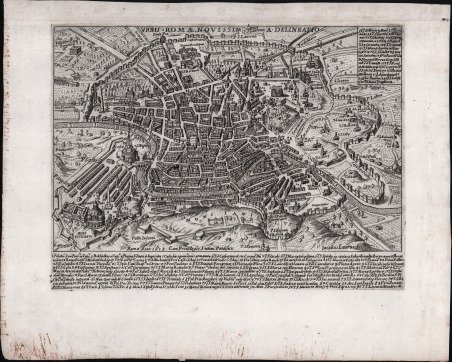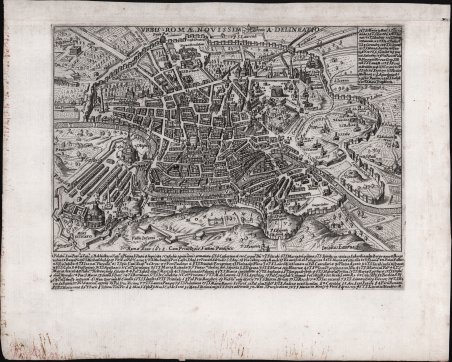Dettagli
Anno di pubblicazione
1618
Incisori
LAURO Giacomo (1561-1645/50)
Soggetto
Roma, Rome, Piante e Panorami di Roma, Maps and General Views of Rome, Roma, Rome
Descrizione
Piccola pianta di Roma proiezione obliqua, orientata col nord a sinistra. "E' evidente la derivazione di questa pianta da quella più grande del Florimi, come giustamente rilevato dalla Jatta nel catalogo Roma Veduta. In basso a sinistra si legge Romae Anno 1618 cum privilegio Summi POntifici ed a destra: Jacobus Laurus f. Sul margine inferiore una legenda di 95 numeri che prosegue nel cartiglio in alto a destra fino al n. 121" (cfr. Marigliani, p. 185). Tuttavia, ci sembra improbabile che sia derivazione del Florimi - che, tra l'altro, comprende una legenda di soli 86 numeri di legenda. Sembra più probabile la derivazione con le piante incise da Ambrogio Brambilla per il Franzini prima e per Nicola van Aelst poi (1590). Pianta tratta dall'Antiquae Urbis Splendor di Giacomo Lauro, opera per la prima volta pubblicata nel 1612, importante e ricercata raccolta di vedute e antichità romane, rappresenta il più importante lavoro del Lauro e godette di una incredibile fortuna. L'opera interamente illustrata con sintetici testi didascalici sulle bellezze e gli splendori di Roma antica e Roma moderna venne ristampata ed accresciuta. Le edizioni posteriori fanno sempre riferimento alla data di pubblicazione del 1612. La data e lo stampatore sono però dedotti dalla dedica di Giovanni Alto (jan Alten) da Lucerna, curatore del volume, ai lettori. Acquaforte e bulino, stampata su carta vergata coeva, in ottimo stato di conservazione. Bibliografia Frutaz n. 26; Scaccia Scarafoni n. 180; Huelsen 49; Roma Veduta n. 22; Marigliani p. 185, n. 90. //// Small map of Rome with an oblique projection, oriented with the north on the left. It is evident the derivation of this map from the larger one of Florimi, as rightly noted by Jatta in the catalog Roma Veduta. In the lower left corner it reads Romae Anno 1618 cum privilegio Summi POntifici and on the right: Jacobus Laurus f. On the lower margin a legend of 95 numbers that continues in the cartouche in the upper right up to n. 121" (cf. Marigliani, p. 185). However, it seems unlikely to us that it is a derivation of the Florimi - which, by the way, includes a legend of only 86 numbers. It seems more likely to be derived from the maps engraved by Ambrogio Brambilla for Franzini first and then for Nicola van Aelst (1590). The map is taken from Antiquae Urbis Splendor by Giacomo Lauro, a work published for the first time in 1612, an important and sought-after collection of Roman views and antiquities, it represents Lauro's most important work and enjoyed an incredible fortune. The work, entirely illustrated with concise didactic texts on the beauties and splendors of ancient and modern Rome, was reprinted and enlarged. Later editions always refer to the date of publication of 1612. The date and the printer are however deduced from the dedication of Giovanni Alto (jan Alten) from Lucerne, editor of the volume, to the readers. Etching and engraving, printed on contemporary laid paper, in excellent condition. Literature Frutaz n. 26; Scaccia Scarafoni n. 180; Huelsen 49; Roma Veduta n. 22; Marigliani p. 185, n. 90.


Scopri come utilizzare
Scopri come utilizzare
